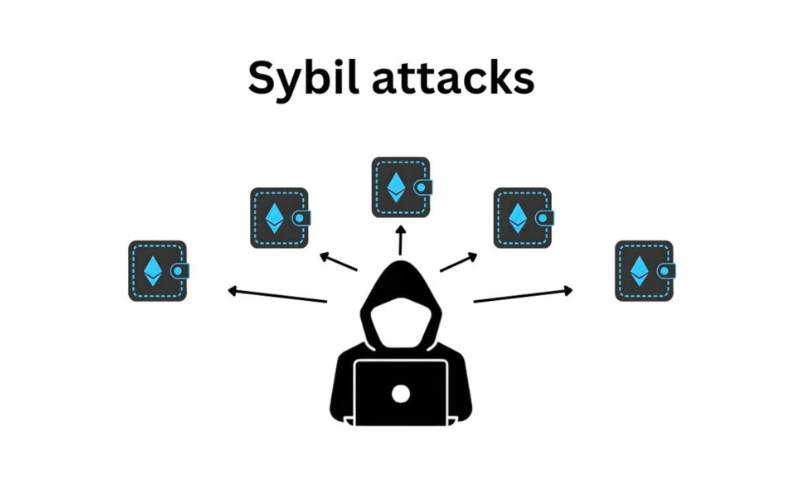Sybil Attacks Unmasked: Protecting Your Blockchain Network
Ever wondered, What is a Sybil attack on blockchain? You’re not alone. It’s a crafty move where one user makes many fake identities, aiming to take over a network. Think of it as one person wearing countless masks, tricking everyone in a room. In the blockchain world, these attacks can mean real trouble. They threaten to upend the trust and safety we expect in decentralized systems.
Let’s peel off these masks together. Picture a blockchain as a busy city. A Sybil attack is like one person sneaking into multiple homes, taking control. To stop them, you need strong defenses. We’ll dive into how to spot this threat and slam the door shut before harm’s done. From understanding the sneakiness to arming your network, we’ll uncover what it takes to stay safe in the crypto space.
Understanding the Basics of Sybil Attacks on Blockchain
Defining the Sybil Attack Phenomenon
What is a Sybil attack in blockchain? A Sybil attack is when one user fakes many identities. These attacks can hurt trust in decentralized networks. They are serious problems for blockchain technology. Each phony identity seems real and separate. Attackers can control parts of the network this way.
Blockchain security vulnerabilities become clear with Sybil attacks. They show the weak spots in peer-to-peer networks. By faking identities, bad actors can mess with node reputations. They can even sway blockchain consensus mechanisms. People made blockchain to cut risks like misuse and fraud. Yet, Sybil attacks can threaten these goals without proper safeguards.
Real-World Examples of Sybil Attacks and Their Consequences
Let’s look at some Sybil attack examples. In cryptocurrency, a Sybil attacker might control many nodes. They do this to double-spend coins. That means they spend the same digital currency more than once. It’s like paying for different things with the same $10 bill. This shakes trust in network systems.
Validating transactions relies on honesty among nodes. Fake identities break this trust. They risk double-spending and wrong data. They can cause doubt across the whole blockchain. Many people see blockchain as a safe way to handle data and money. Yet, Sybil attacks threaten this image.
Combatting these attacks is vital for blockchain tech. People must know they can trust what happens on the network. If not, they may not use blockchain. This would derail many advances in our digital world. So, we need strong plans to prevent Sybil attacks. These include checking who joins the network and how nodes behave. We must be sure we can spot these frauds.
If someone succeeds in a Sybil attack, what’s the impact? Trust goes down. People might take their money and data elsewhere. Other systems might not face these attacks. They could be more tempting than blockchain. So, if we let Sybil attacks win, blockchain’s bright future could dim. We need to keep improving ways to stop these threats.
In dealing with Sybil attacks, we can’t forget blockchain’s key feature. It offers pseudonymity while sharing data. This means users can interact without sharing personal info. But this must not lead to more risks. Node validation processes help keep this balance. They keep blockchain’s promise without losing security.
By keeping an eye out for these attacks, we can stop them. This will help everyone feel secure using blockchain. It will mean trust in technology keeps growing. Remember, every fake node caught is a win for everyone. A safe blockchain is one where all feel sure their data and money are secure.
The Anatomy of Blockchain Security and Vulnerabilities
Node Identities: The Achilles’ Heel in Decentralized Systems
In a blockchain, every participant we call a node plays a crucial part. These nodes handle transactions, keeping the network alive. Yet, they are also where security risks, like Sybil attacks, hide. Such an attack happens when one user controls many fake nodes. This tricks the system into believing many different users are there. In a nutshell, a Sybil attack is when one person pretends to be many on a network.
The health of blockchain relies on trust and the idea that nodes work for the network’s good. But Sybil attacks threaten this trust. A person with bad intent can use fake identities to gain control. They can mess with things like voting in a decentralized way. This can stop honest transactions, or worse, manipulate them.
When we talk about blockchain technology, trust is a big thing. We need to know that the person on the other end is who they say they are. With fake identities, this trust erodes. Think of it like someone slipping on masks and trying to vote many times. It’s a real problem in decentralized networks.
Evaluating Blockchain Consensus Mechanisms Against Sybil Threats
Consensus mechanisms are the rules that help blockchains agree on which transactions are valid. They also help keep out unwanted Sybil threats. There are two main types: proof of work and proof of stake. In proof of work, miners solve tough puzzles to add new blocks. This needs lots of computer power. So, it’s hard for Sybil attackers to have enough to control the network.
Proof of stake is different. Here, the more of the currency you have, the more power you get to add blocks. This means you would need to own a lot of the coins to attack the network. Both ways help prevent multiple identities fraud by making attacks expensive or tough to do.
Each of these mechanisms aims to keep a fair and secure system. But no method is perfect. Hackers always look for new ways to attack. This means the blockchain community must stay alert and keep improving security measures.
Knowing how these attacks happen helps us fight them better. We always have to be smarter than those trying to break the trust on our networks. It’s like a game of cat and mouse. But it’s serious business, as it deals with people’s real money and trust.
When we think about validating transactions, we need to be tough on security. This means using smart software to spot Sybil attacks early. Blockchain security vulnerabilities are like holes in a ship. If too many appear, the ship might sink. This is why we invest time in making sure these holes are filled.
The stakes are high. In the world of cryptocurrency, a successful attack could wipe out trust very fast. Everyone has heard of hacking and stolen money tales. These stories remind us why we must fight Sybil attacks at every turn. Keeping up with the latest in node reputation systems and cybersecurity keeps blockchains safe. This is our goal—a secure, reliable network that everyone can trust.
Frontline Defenses: Combating Sybil Attacks Effectively
The Role of Node Reputation Systems in Preventing Fraud
You must have heard of a break-in. A Sybil attack is like a break-in, but in the blockchain world. It’s where bad folks make many fake identities. They do this to gain control and cause trouble. Imagine one person with a bunch of masks, tricking others that they’re many different people. That’s a Sybil attack in simple words.
Now, how do we stop these tricky attacks? Think about a neighborhood watch. It’s a group of people keeping an eye out for anything fishy. In blockchain, we have something similar called node reputation systems. These systems keep a close watch on everyone in the network.
Node reputation systems score each participant. A high score means they’re trusted. A low score? Not so much. They’re like a credit score, but for blockchain trustworthiness. When nodes do good things, they earn a better reputation. This helps stop fake identities from causing harm. Good guys get a say, and the bad guys don’t.
Let’s dive deeper. Nodes are computers on the blockchain. They help validate transactions. If they act weird or break rules, their score drops. Other nodes will start to ignore them. It’s like getting the cold shoulder for being sneaky. This keeps the whole network safe and honest. It makes it tough for one person, or a group, to attack with fake masks. This way, we all help guard the playground.
Innovative Cryptographic and Protocol-Based Solutions
Cryptographic solutions are like magic spells that protect us. They’re complex math problems that are super hard to solve without a key. Think of it like a treasure chest with a special lock. Only the person with the right key can open it.
In blockchain, cryptography keeps our stuff safe. It stops people from pretending to be someone they’re not. When I send you a secret note (or in tech talk, a transaction), it’s locked up tight. Only you can read it because only you have the key. It’s a way to prove who we really are without shouting our names to the world.
Now, let’s talk protocols. These are like the rules of a game. In blockchain, our game has special rules to stop the Sybil attack. There are two main types: proof of work and proof of stake.
Proof of work is a tough puzzle-solving contest. Think of it like a race where finding the finish line takes a lot of energy. You can’t cheat because you need to show your work. It keeps the Sybil attackers away because they’d get too tired.
Proof of stake, on the other hand, is like a trust circle. You show how much you care by putting in something valuable. The more you put in, the more you can be trusted. It’s like showing you’re serious by betting your favorite toy. This makes it costly for the bad guys to mess with us.
Together, these magical spells (cryptography) and game rules (protocols) protect our blockchain world. They check to make sure no one is wearing a bunch of masks. It helps keep every deal fair and every buddy honest.
So, always remember, in the vast playground of blockchain, staying safe means playing smart and playing together. Thanks to these smart defenses, you can trade and trust without worry. Keep your eyes open, and keep your blockchain strong!
Building Resilience: Future-Proof Strategies Against Network Attacks
Enforcing Identity Verification and Authentication in Blockchain
Imagine a party where anyone can wear a mask. They can even wear many, pretending to be many guests. This can cause chaos. This is what a Sybil attack in the blockchain world is like. Someone creates many fake node identities. They use these to harm the network. They could steal money or mess up important data. This isn’t good for anyone.
To stop this, we check who comes to our blockchain party. We make sure each person, or node, is who they say they are. This is called identity verification. We ask for a “ticket” that is hard to fake. In blockchain, this ticket is often a secret code, like a key. Everyone gets their own unique key. This helps us keep out the fakes.
What if a node loses its key, or someone steals it? We check their ID again. This is called authentication. It’s like a double-check to make sure all nodes at our party are the real deal. This helps us keep our blockchain safe and sound. We use clever math to do this. It’s like a secret handshake that only the true nodes know.
Advancing Sybil-Resistant Mechanisms: From Byzantine Fault Tolerance to Advanced Algorithms
Now, we know about Byzantine faults. They mean even if some guests at the party are tricky, we’re okay. Our party still goes on without a problem. Byzantine fault tolerance is our friend. It keeps our blockchain working smooth even if some nodes act bad.
How do we do this? We use advanced math and rules, called algorithms. These are like the rules of our party. They tell us how to agree on what’s what. There are different ways to do this in blockchain, like proof of work or proof of stake.
In proof of work, nodes do hard puzzles to show they’re working hard. It’s like a ticket to enter the party. It costs a lot to fake this ticket, so bad nodes stay away.
In proof of stake, nodes show they own part of our blockchain club. They put up their own money. This means if they mess up our party, they lose, too. It’s like saying, “I care about our club, so I’ll play nice.”
We also have these things called “node reputation systems.” They are like a score for each guest at our party. If a node plays by the rules and does good things, its score goes up. Think of it as a trust score. If you have a high score, we trust you more. This helps make sure no one can harm our blockchain by using lots of fake masks.
Always, we keep an eye out for Sybil attacks. We look for signs that someone is trying to wear lots of masks. If we catch them, we kick them out of the party. This keeps our trust high, and our blockchain strong.
Protecting our blockchain from network attacks is like keeping our party safe. We use smart rules and checks to make sure everyone dances to the same beat. Together, we make sure our blockchain party is the best it can be, free from crashers and chaos-makers.
We’ve explored how sneaky Sybil attacks can disrupt blockchain. Remember, a Sybil attack is when one user forms a bunch of fake identities. We saw real stories of how this can shake up networks. We looked inside blockchain defense, spotting weak spots like node identities. We checked out how blockchains decide on truth and how this can fend off Sybil tricks.
Then, we talked about the frontline defense. We learned how keeping tabs on node reputations helps. We also saw smart codes and rules that block these attacks. Last up, we tackled future-proofing. This means making sure that every player proves who they are and using even brainier math and rules to stop Sybils.
My final thought? Staying ahead of clever attacks means we must be even cleverer. Always build stronger, smarter blockchains ready to knock back any tricks. That’s the drill for keeping our networks safe today and tomorrow.
Q&A :
What Exactly Constitutes a Sybil Attack in Blockchain Technology?
In blockchain technology, a Sybil attack refers to a security breach where one person or entity creates multiple fake identities to gain a disproportionately large influence on the network. This type of attack exploits the decentralized and pseudonymous nature of blockchain by creating numerous phantom nodes, potentially allowing the attacker to subvert network operations such as consensus or trust mechanisms to their benefit.
How Can a Sybil Attack Affect a Blockchain Network?
A Sybil attack can have various negative impacts on a blockchain network. It can disrupt the consensus process, leading to forks or double-spending. The attacker may also undermine trust in the network by falsifying transaction histories or manipulating smart contracts. Maintaining the integrity of the network’s security protocols is key to preventing such disruptions.
What Mechanisms Are in Place to Prevent Sybil Attacks in Blockchain?
Blockchain networks often use mechanisms like Proof of Work (PoW), Proof of Stake (PoS), or delegated consensus mechanisms to prevent Sybil attacks. These methods require the validation of new transactions or the creation of new blocks to be tied to a resource that cannot be easily replicated or faked, such as computational power or a stake in the network’s token.
How Does Proof of Work Deter Sybil Attacks?
Proof of Work (PoW) combats Sybil attacks by making it computationally expensive to create and maintain multiple identities. Since each identity needs to solve complex mathematical puzzles to validate transactions or mine new blocks, the resources required to carry out a successful Sybil attack become prohibitive, thereby securing the network against such manipulation.
Are Private Blockchains Immune to Sybil Attacks?
While private or permissioned blockchains are not completely immune to Sybil attacks, they are less vulnerable compared to public blockchains. In private blockchain networks, participants are usually vetted and authorized before gaining access. Tighter control over who is allowed to participate reduces the risk of an attacker being able to create multiple identities within the network.


